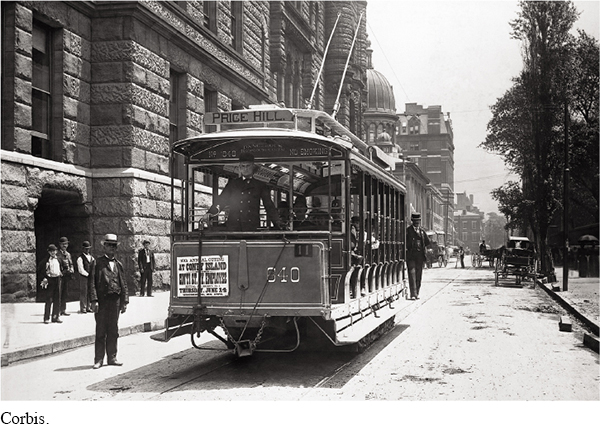The American Promise: Printed Page 535
The American Promise, Value Edition: Printed Page 492
The American Promise: A Concise History: Printed Page 558
The Social Geography of the City
The American Promise: Printed Page 535
The American Promise, Value Edition: Printed Page 492
The American Promise: A Concise History: Printed Page 558
Page 535During the Gilded Age, the social geography of the city changed enormously. Cleveland, Ohio, provides a good example. In the 1870s, Cleveland was a small city in both population and area. Oil magnate John D. Rockefeller could, and often did, walk from his large brick house on Euclid Avenue to his office downtown. On his way, he passed the small homes of his clerks and other middle-
Within two decades, the Cleveland that Rockefeller knew no longer existed. The coming of mass transit transformed the walking city. In its place emerged a central business district surrounded by concentric rings of residences organized by ethnicity and income. First the horsecar in the 1870s and then the electric streetcar in the 1880s made it possible for those who could afford the five-

Race and ethnicity affected the way cities evolved. Newcomers to the nation’s cities faced hostility and, not surprisingly, sought out their kin and countryfolk as they struggled to get ahead. Distinct ethnic neighborhoods often formed around a synagogue or church. African Americans typically experienced the greatest residential segregation, but every large city had its distinct ethnic neighborhoods—
Poverty, crowding, dirt, and disease constituted the daily reality of New York City’s immigrant poor—
However, Riis’s book, like his photographs, presented a world of black and white. There were many layers to the population Riis labeled “the other half”—distinctions deepened by ethnicity, religion, race, and gender. How the Other Half Lives must be read more as a reformer’s call to action than as an entirely accurate portrayal of the varied and complex lives of “the other half.” But it served its purpose. Tenement reform and city playgrounds grew out of Riis’s exposé.
The American Promise: Printed Page 535
The American Promise, Value Edition: Printed Page 492
The American Promise: A Concise History: Printed Page 558
Page 536While Riis’s audience shivered at his revelations about the “other half,” many middle-
The excesses of the Gilded Age’s newly minted millionaires were nowhere more visible than in the lifestyle of the Vanderbilts. Cornelius “Commodore” Vanderbilt, the uncouth ferryman who built the New York Central Railroad, died in 1877. Today he still holds first place among the richest men in America (when adjusted for inflation). He left his son William $90 million. William doubled the sum, and his two sons proceeded to spend it on Fifth Avenue mansions and “cottages” in Newport, Rhode Island, that sought to rival the palaces of Europe. Alva Vanderbilt, looked down on by the old-
Such ostentatious displays of wealth became especially alarming when they were coupled with disdain for the well-
The American Promise: Printed Page 535
The American Promise, Value Edition: Printed Page 492
The American Promise: A Concise History: Printed Page 558
Page 537REVIEW Why did American cities experience explosive growth in the late nineteenth century?